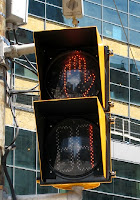 At Zurich Airport Orange and Nokia are running a large printed advert. At a first glance it looks just as a printed large scale poster. The TV screen in one poster and the projected writing on top of another poster are seamlessly integrated. The media design of the overall installation is appealing.
At Zurich Airport Orange and Nokia are running a large printed advert. At a first glance it looks just as a printed large scale poster. The TV screen in one poster and the projected writing on top of another poster are seamlessly integrated. The media design of the overall installation is appealing.
 The active screen (could be a 50 inch plasma TV) is the screen of the mobile phone and shows the navigation application. In contrast to most other installations, where screens and printed posters are used, this appears right and it catches people’s attention.
The active screen (could be a 50 inch plasma TV) is the screen of the mobile phone and shows the navigation application. In contrast to most other installations, where screens and printed posters are used, this appears right and it catches people’s attention.
There is work from Scott Klemmer’s group at Stanford that looks the relationship between the printed displays and projection/displays for various applications. The Gigaprints project was shown as a video at Ubicomp 2006.




